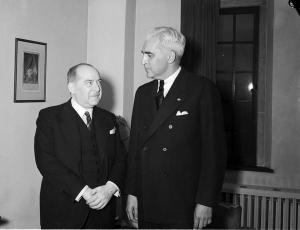By: Allison Larmann, Bicentennial Intern, Class of 2017, International Studies Major, Bloomington
I am a senior studying International Studies with a certificate in the Liberal Arts and Management Program and a minor in Marketing. The bicentennial internship interested me because it was a perfect way to expand upon the research skills I have learned through my classes while supporting Indiana University as it prepares for its bicentennial celebration!
I am really grateful that I was able to be a bicentennial intern before I graduated so that I could learn more about Indiana University’s history as well as reflect upon my past four years at IU and think about all of the skills I have learned to prepare for my future.

The Two Projects
As an International Studies major, I was interested in completing a project regarding Indiana University’s impact on international institutions. As I looked into exactly how to formulate my project I realized that IU’s impact on the state and national level was also equally impressive and that should be recognized. Additionally, my bicentennial supervisor James Capshew, University Historian, was really interested to see who from IU has had an obituary in The New York Times.
This seemed like a really great opportunity to learn more about IU’s most notable students and faculty, so I added this as a side project. I decided the best way to keep track of all of the data I was compiling would be through excel sheets.
Civil Service: Who Is In and Who Is Out?
The first task with compiling the list of alumni that have been in civil service positions is what actually constitutes a member of the civil service? After meeting with my bicentennial supervisor we decided that the best idea would be to create our list around the premise that civil service could include anyone at the local, state, national and supranational level that held a position in the government who has not held a position in the armed forces.
This was my first challenge to overcome in the project. The next challenge was how to efficiently create this database; the answer: use a four pronged approach through books on IU history, the Indiana University Archives, online databases, and websites.
A database of this style has not yet been completed by IU so I was really looking forward to delving into uncharted territory. I really appreciated the access to the Indiana University Archives because of the massive amount of materials that were able to be accessed on a variety of subjects, including alumni in the civil service.
The research itself was very fascinating and discovering the wide variety of positions and accomplishments in the civil service by our alumni made me proud to be a Hoosier. Some of the most notable people on the list include Ambassador Feisal Istrabadi, the former Ambassador from Iraq to the United Nations and currently a professor at IU, Frederick Landis, the former Chief Justice of the Indiana Supreme Court, and Cheryl Lau, first woman to serve as general counsel of the U.S. House of Representatives.

The Challenge of The New York Times Obituaries
The New York Times began in 1851 and initially covered mostly local news but quickly gained fame as a highly regarded national newspaper. At first this side project sounded simple, search for “Indiana University” in The New York Times and create a list with the pertinent information. This works until the search does not exactly find the type of articles you want and mix basketball scores with obituaries of anyone who passed away in the state of Indiana.
This tested my belief that everything could be found on the internet if you just searched for it, that is not true. First, there was the challenge of the name of the university. There were articles that wrote the University of Indiana, Indiana U, or other variations of our actual school name. Also, there are some obituaries that left out the name of Indiana University in general instead choosing to focus on later career achievements.
This project relied on multiple different sources being brought together primarily The New York Times website, ProQuest New York Times database, and the Indiana University Archives. The impressive expanse of Indiana University’s name in The New York Times obituary section has spanned almost the entire length of The New York Times publication from the late 19th century up to today. It was really interesting to see the amazing lives that Indiana University has helped shape throughout its history.
These two projects have had their challenges, but I have loved the experience and the knowledge I have gained. My favorite take away has been while researching how much I have learned about IU’s amazing alumni and the impressive amount they have accomplished throughout the almost 200 years of this institution.
I am really proud that Indiana University now have these two lists that can be utilized by future interns and for the bicentennial celebrations.
Read more about this project here: https://blogs.iu.edu/bicentennialblogs/2017/05/26/ius-most-notable-alumni-the-new-york-times/